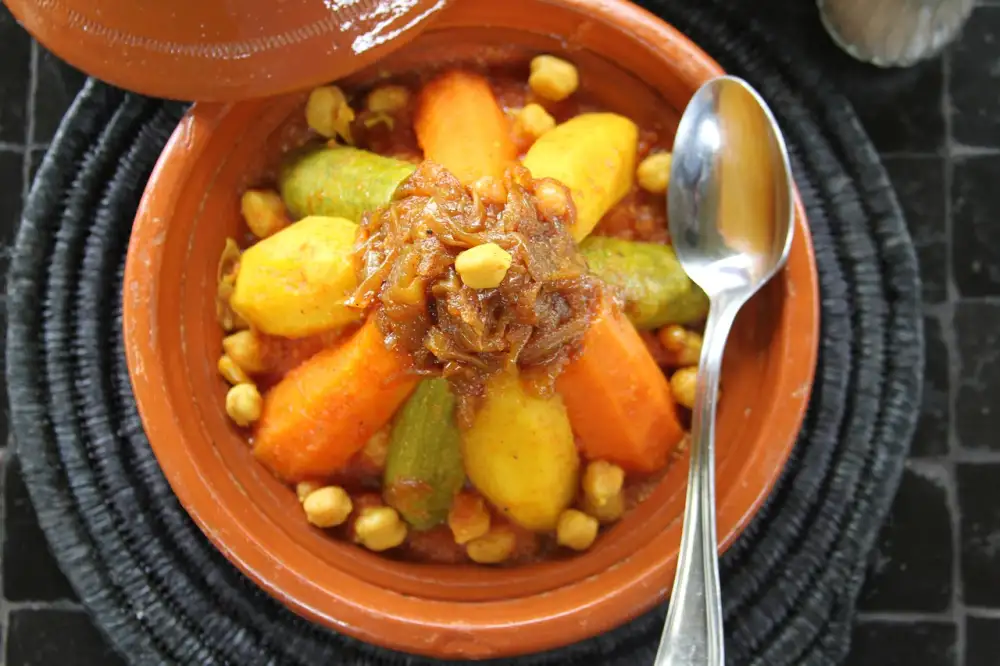Culinary Delights: Unleash the Magic of Couscous with These Delectable Recipes

- History and Origins of Couscous
- Health Benefits of Couscous
- Basic Cooking Techniques for Couscous
- Traditional Couscous Recipes from North Africa
- Variations of Couscous Recipes from Around the World
- Vegetarian and Vegan Couscous Recipes
- Couscous Salads and Side Dishes
- Couscous as a Main Course
- Desserts and Sweet Treats with Couscous
- Tips and Tricks for Perfecting Couscous Dishes
Couscous, a tiny grain-like pasta, has become a beloved ingredient in kitchens around the world. With its delicate texture and ability to absorb flavors, couscous is a versatile base for countless delicious recipes. From savory main courses to refreshing salads and even sweet desserts, the possibilities are endless. Whether you're a seasoned chef or a beginner in the kitchen, exploring the world of couscous recipes will surely ignite your culinary creativity. Get ready to embark on a flavorful journey as we uncover the magic of couscous in this delectable article.
History and Origins of Couscous
Couscous, a staple in North African cuisine, has a rich history that dates back centuries. Its origins can be traced to the Berbers, an indigenous group from the Maghreb region of Africa. The exact timeframe of couscous's emergence is unclear, but it is believed to have been consumed as early as the 9th century.
Originally made by hand-rolling semolina wheat into tiny granules, couscous was traditionally prepared by women in large communal pots. This labor-intensive process required skill and patience. Over time, specialized utensils like the couscoussier (a double-chambered steamer pot) were developed to simplify the cooking process.
Couscous gained popularity beyond North Africa during the Arab conquests of the 7th century. It spread throughout the Mediterranean region and eventually reached Europe. Today, couscous is enjoyed worldwide and has become a versatile ingredient in various cuisines.
The cultural significance of couscous cannot be overstated. In many North African countries, it holds symbolic value and is often served during special occasions and religious festivals. It is a dish that brings people together, fostering a sense of community and celebration.
As we explore different couscous recipes in this article, let us appreciate the historical roots of this beloved grain and pay homage to its enduring legacy in culinary traditions across the globe.
Health Benefits of Couscous
Couscous is not only a delicious and versatile ingredient, but it also offers several health benefits. Firstly, couscous is a good source of complex carbohydrates, providing sustained energy and keeping you feeling full for longer. It is also low in fat and cholesterol-free, making it a heart-healthy choice. Additionally, couscous is rich in fiber, aiding digestion and promoting a healthy gut. It contains essential minerals such as potassium, magnesium, and iron, which are important for maintaining proper bodily functions. With its nutritional profile and health benefits, couscous is an excellent addition to any balanced diet.
Basic Cooking Techniques for Couscous
Cooking couscous is a simple process that requires minimal effort. Start by bringing water or broth to a boil in a pot. The general rule is to use 1 ½ cups of liquid for every cup of couscous. Once the liquid reaches a boil, remove it from the heat and add the couscous. Stir gently to ensure all the grains are submerged, then cover the pot tightly with a lid and let it sit for about 5 minutes. Afterward, fluff the couscous with a fork to separate the grains and add any desired seasonings or ingredients. This versatile grain can be cooked using different liquids like vegetable or chicken broth for added flavor. Experiment with spices, herbs, and vegetables to create unique variations of this beloved dish.
Traditional Couscous Recipes from North Africa
North Africa is the birthplace of couscous, and its cuisine boasts an array of mouthwatering traditional recipes. One such classic is the Moroccan couscous, a fragrant dish made with tender lamb or chicken, vegetables, and a blend of aromatic spices like cumin, coriander, and turmeric. Another popular variation is the Tunisian couscous, which features spicy merguez sausages, chickpeas, and harissa for a fiery kick. Algerian couscous often includes succulent braised meat such as beef or lamb, along with root vegetables like carrots and turnips. These rich and flavorful dishes truly capture the essence of North African cuisine and are sure to transport your taste buds to exotic lands.
Variations of Couscous Recipes from Around the World
Couscous, with its versatility and ability to absorb flavors, has become a staple in many cuisines around the world. From the Middle East to Europe and beyond, different regions have put their own spin on this beloved grain. In Morocco, for example, couscous is often paired with tender lamb and aromatic spices like cinnamon and cumin. In Tunisia, it is common to find couscous served with spicy harissa sauce and fresh seafood. In France, couscous is often used as a base for hearty stews or served alongside roasted vegetables. And in Israel, couscous is frequently used in salads or mixed with herbs and spices for a flavorful side dish. These variations highlight the adaptability of couscous and how it can be incorporated into diverse culinary traditions. Whether you prefer bold flavors or subtle combinations, there's a couscous recipe out there that will surely satisfy your taste buds. So why not explore the world of couscous and discover new flavors from different cultures?
Vegetarian and Vegan Couscous Recipes
Vegetarian and vegan couscous recipes offer a delightful array of flavors for those who prefer plant-based options. One popular choice is the Mediterranean vegetable couscous, packed with colorful bell peppers, zucchini, and cherry tomatoes. For a burst of freshness, try a lemon and herb couscous salad, combining fragrant herbs like parsley and mint with tangy lemon juice. Another option is the Moroccan-style chickpea couscous, featuring tender chickpeas cooked in aromatic spices like cumin and coriander. These recipes showcase the versatility of couscous while providing nourishing options for vegetarians and vegans alike.
Couscous Salads and Side Dishes
Couscous is not only a versatile ingredient for main courses, but it also shines in salads and side dishes. Its light and fluffy texture makes it the perfect base for refreshing salads that are packed with flavor. One popular option is the Mediterranean couscous salad, which combines cooked couscous with fresh vegetables like tomatoes, cucumbers, and bell peppers. Tossed in a tangy lemon vinaigrette and garnished with herbs like parsley and mint, this salad is a refreshing addition to any meal. Another delicious option is the Moroccan-style couscous salad, which features a mix of sweet and savory flavors. It includes ingredients like dried fruits, nuts, herbs, and spices such as cinnamon and cumin. The combination of textures and flavors creates a truly unique dish that will impress your guests. If you're looking for a heartier side dish, try adding roasted vegetables or grilled chicken to your couscous. The possibilities are endless when it comes to creating flavorful salads and side dishes with couscous. So go ahead and unleash your creativity in the kitchen!
Couscous as a Main Course
Couscous is not only a versatile ingredient, but it can also take center stage as a main course. With its light and fluffy texture, couscous makes for a satisfying and filling meal. One popular way to enjoy couscous as a main course is by pairing it with vegetables and protein. For example, you can sauté some onions, bell peppers, and zucchini, then add cooked chickpeas or grilled chicken. Mix in the cooked couscous and season with herbs and spices of your choice. Another delicious option is to make stuffed bell peppers or tomatoes with couscous filling. Simply cook the couscous according to package instructions and mix it with diced vegetables, herbs, and feta cheese. Stuff the mixture into hollowed-out bell peppers or tomatoes and bake until tender. The possibilities are endless when it comes to using couscous as a main course – let your creativity shine in the kitchen!
Desserts and Sweet Treats with Couscous
Couscous isn't just limited to savory dishes; it can also be transformed into delightful desserts and sweet treats. Its mild flavor and unique texture make it a versatile ingredient for creating delectable desserts.
One popular dessert is couscous pudding. Cooked couscous is combined with milk, sugar, and aromatic spices like cinnamon or cardamom. The mixture is then simmered until the couscous absorbs the flavors and becomes creamy. Served warm or chilled, this pudding is a comforting and satisfying dessert option.
For a lighter option, couscous can be used to make fruit salads. Simply toss cooked couscous with fresh fruits like berries, diced melons, and citrus segments. A drizzle of honey or a squeeze of lemon juice adds a touch of sweetness and enhances the flavors.
Another creative way to use couscous in desserts is by incorporating it into cakes or muffins. Ground couscous can replace some of the flour in your favorite recipes, adding a unique texture and nutty flavor. You can also add dried fruits or nuts for extra indulgence.
Couscous can even be transformed into sweet dumplings by mixing it with butter, sugar, and spices such as nutmeg or vanilla. These dumplings are then steamed until tender and served with a drizzle of honey or syrup.
With its versatility and ability to absorb flavors, couscous opens up endless possibilities for creating delicious desserts that will surprise your taste buds. So why not unleash your creativity in the kitchen and explore the sweeter side of couscous?
Tips and Tricks for Perfecting Couscous Dishes
1. Fluff it up: After cooking couscous, use a fork to fluff the grains. This will prevent them from clumping together and create a light, fluffy texture.
2. Use the right ratio: For perfect couscous, follow the recommended water-to-couscous ratio. Typically, it's one part couscous to one and a half parts water or broth.
3. Add flavor with broth: Instead of using plain water, cook couscous in vegetable or chicken broth. This will infuse it with delicious flavors and enhance the overall taste of your dish.
4. Toast the grains: Before cooking, toast the couscous in a dry pan for a few minutes. This step adds a nutty flavor and helps to keep the grains separate during cooking.
5. Let it rest: Once cooked, let the couscous rest for a few minutes before fluffing it up. This allows any remaining moisture to be absorbed evenly throughout the grains.
6. Experiment with spices: Couscous is incredibly versatile when it comes to flavors. Try adding spices like cumin, turmeric, or paprika to give your dish an extra kick.
7. Get creative with mix-ins: Customize your couscous by adding chopped vegetables, dried fruits, nuts, or herbs. These additions not only add texture but also bring additional flavors to your dish.
8. Serve it hot or cold: Couscous can be enjoyed both hot and cold, making it perfect for salads or as a side dish for grilled meats or roasted vegetables.
By following these tips and tricks, you'll be able to create delicious and perfectly cooked couscous dishes every time!
In conclusion, couscous is a versatile ingredient that can elevate your culinary creations to new heights. Its rich history and origins in North Africa add a touch of tradition to any dish. Not only is it easy to cook, but it also offers numerous health benefits, making it a great choice for those looking for nutritious options. Whether you prefer traditional recipes or want to explore variations from around the world, there is a couscous dish for everyone. From vegetarian and vegan options to delicious salads, main courses, and even desserts, the possibilities are endless. So why not unleash the magic of couscous in your kitchen and savor the flavors it brings? Let your creativity run wild and enjoy the delightful journey of exploring this incredible ingredient.
Published: 28. 11. 2023
Category: Food



